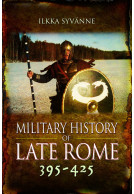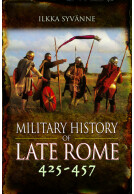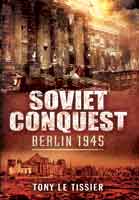Military History of Late Rome 284-361 (Paperback)
Imprint: Pen & Sword Military
Pages: 464
Illustrations: 32 colour & black and white maps & battle diagrams
ISBN: 9781399085144
Published: 26th November 2021
(click here for international delivery rates)
Order within the next 19 minutes to get your order processed the next working day!
Need a currency converter? Check XE.com for live rates
| Other formats available | Price |
|---|---|
| Military History of Late Rome… ePub (60.8 MB) Add to Basket | £6.99 |
This ambitious series gives the reader a comprehensive narrative of late Roman military history from 284-641. Each volume (5 are planned) gives a detailed account of the changes in organization, equipment, strategy and tactics among both the Roman forces and her enemies in the relevant period, while also giving a detailed but accessible account of the campaigns and battles.
Volume I covers the period 284-361, starting with recovery from the 'third-century crisis' and the formation of the Tetrarchy. Constantine's civil wars and stabilization.are also major themes, with the pattern repeated under his sons. Constantius II's wars against the usurper Magnentius, the Danubian tribes and the Sassanid Persians illustrate the serious combination of internal and external threats the Empire faced at this time. The author discusses these and the many other dramatic military events in their full context and puts forward some interesting conclusions on strategic and tactical developments. He argues, for example, that the Roman shift from infantry to cavalry as the dominant arm occurred considerably earlier than usually accepted. Anyone with an interest in the military history of this period will find it both informative and thought-provoking.
“An outstanding work… [the series] gives us a very good picture of the long process that has come to be known as the “Fall of Rome”. This is an invaluable read for anyone with an interest in Late Antiquity.”
The NYMAS Review
Although it's clear from the outset that this book is a well-researched and ambitious study and that the author has a lot to say, his message is emphatically meant for those readers who are already versed in the subject.
Ancient Warfare, March/April 2018 - reviewed by Robert Vermaat
As featured 'on the shelf' by Neil Smith
Wargames Illustrated, June 2017
This is a valuable overview of a period in which the Roman Empire was clearly still militarily powerful and resilient, capable of overcoming a series of internal threats and external enemies, and restoring her borders after the sort of Barbarian invasions that in the next century would see the fall of the Western Empire. I'm looking forward to volume two.
History of War
Read the full review here.
As featured in
Slingshot, July/August 2016
As featured in
Desperta Ferro, No. 37
Un ouvrage tres documente qui fait autorite sur un sujet peu etudie et passionnant.
Ex Libris: L'actualite litteraire disponsible en librairie
Translate:
A very documented book that makes authority on a subject little studied and exciting.
This reviewer believes the work provides a comprehensive examination of Rome’s military history during this period of the empire and looks forward to the forthcoming volumes.
ASMEA - Association for the Study of the Middle East and Africa - Dr. Wyndham Whynot
In January I picked up a copy of the Military History of Late Rome (vol 1) 284-361 (AD) by Dr Ilkka Syvanne and I think that this book deserves to be recognized so here is my review.
Curtis Bisgrove
So the 1st chapter of the book starts off with an overview of the Roman Empire in the 3rd century AD, examining the Roman government and society. The Roman armed forces are looked at from their overall strategy, generalship, cavalry and infantry tactics, the unit structure of the Legions and Auxiliaries, Intelligence gathering, equipment, logistics, the composition of the navy and how it operated, down to the recruitment and the relationship Roman troops had with civilians.
In particular, a very useful subsection to the chapter is the self-explanatory Civilians Guarding and Policing the Interior and Borders of the Empire.
Chapter 2 entitled Enemies and Allies, is one of the reasons that this is one of the most useful books on my shelf.
The chapter is as its name suggests a detailed examination of the tribes and political entities that Rome had contact with outside the empire and their societies, governments and militaries. This section alone makes me almost daily pull this book off of my shelf and look into some tribe/kingdom and it's composition. I have found the sections on the Sassanid Persian Empire and the Gothic tribal confederations of the Tervingi, Greuthungi and their sub-tribes especially helpful.
The book examines the History of the 3rd Century Crisis and then goes into the military takeover of Diocletian.
Ilkka Syvanne gives a phenomenal account of the creation of the Tetrarchy (a system of government with 2 senior emperors titled Augustus, and 2 junior emperors titled Caesar), the forced 'retirement' of the senior emperors Diocletian and Maximian, at the hands of the Caesar Galerius. The usurpations of Maxentius and Constantine I and the civil wars that led to Constantine I eliminating his rivals and ruling alone.
The division of the empire after Constantine's death between his sons, civil wars fought by Constans and Constantine II, defence of the east by Constantius II, and the usurpation of Julian.
In conclusion, Ilkka Syvanne provides a detailed history of the period of 284-361, the campaigns and battles down to the marching formations and the specific tactics used by cohorts, legions and detachments in the specific battles. Throughout the book, Dr Syvanne carefully examines the sources to find the most likely way that each event would have occurred.
Overall this is a fantastic, well-researched book that makes a great addition to my growing collection of Late Roman History books. Money well spent!
About Dr Ilkka Syvanne
DR ILKKA SYVÄNNE* gained his doctorate in history in 2004 from the University of Tampere in his native Finland. Since then he has written extensively about ancient and medieval warfare and his publications include: The Age of Hippotoxotai, Art of War in Roman Military Revival and Disaster 491-636 (Tampere UP 2004), the multi-volume Military History of Late Rome published by Pen & Sword and the critically acclaimed Caracalla: A Military Biography also published by Pen & Sword. He is the co-author with Professor Katarzyna Maksymiuk of The Military History of Third Century Iran (Siedlce UP, 2018) and The Military History of Fifth Century Iran (Siedlce UP, 2019). He was Vice Chairman of the Finnish Society for Byzantine Studies from 2007 until 2016. He was appointed as an Affiliated Professor of the University of Haifa in 2016. He lives in Kangasala, Finland.




















